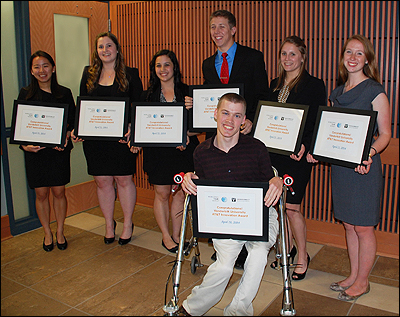A bustling, buzzing crowd toured two floors of Featheringill Hall April 21 to see more than 60 innovative and entertaining engineering design projects created by teams of seniors who have devoted the better part of two semesters solving design problems.
 “This year’s event generated more buzz than ever before. An article in The Tennessean about the event led to a recruiter for a global medical device company contacting me about recruiting our students,” said Associate Dean Cynthia Paschal, who serves as senior design coordinator. The event also was featured as a lead item in the American Society for Engineering Education’s First Bell news roundup of nationwide engineering happenings.
“This year’s event generated more buzz than ever before. An article in The Tennessean about the event led to a recruiter for a global medical device company contacting me about recruiting our students,” said Associate Dean Cynthia Paschal, who serves as senior design coordinator. The event also was featured as a lead item in the American Society for Engineering Education’s First Bell news roundup of nationwide engineering happenings.
“Engineers from a major global aerospace and defense company said that the team they sponsored, ‘far exceeded our wildest expectations’ in completing a project for disarmament of improvised explosive devices,” said Dean Paschal. “A better layout with more space allotted for easier access to everything – from a racecar to microdevices and prototypes of everything in between – made it much easier to appreciate student design achievements this year.”
The event lasted longer this year, too. Teams set up projects shortly after noon in order to accommodate project sponsors and media arriving at 3 p.m., an hour before the official opening of the School of Engineering’s annual Design Day. At the 6 p.m. close, there was a standing-room-only crowd to learn which project had won AT&T’s 2014 Innovation Award, a first-time honor from the company.

The JustMyPace project team captured the AT&T Innovation Award for its working prototype of a modified Kaye Reverse Walker for a Vanderbilt University Medical Center cerebral palsy patient.
The award was presented by AT&T University Relations Manager Ryan Jenkins to biomedical engineering seniors Elaine Simpson, Christy Hsu, Annie Daorai, Pere Cvitanovic, and mechanical engineering students Jacob Books and Molly Cowan. The recognition includes a $1,000 award.
The team’s front wheel braking system easily integrated onto an existing walker with swivel front wheels. It requires only a minimum amount of exertion to engage and disengage the brakes, and provides sustained engagement on the trigger without constant force by the user. ,
“Their design did in a very direct way what all designs need to do — improve lives. It was really exciting to see the immediate, positive impact these students’ design had on their client,” Paschal said.
Finalists include electrical engineering and computer science students Brian Neaves, Seth Patton, Muhammad Ahmad and Wan Ibrahim of the Camgian Microsystems M2M project, and mechanical engineering students William Yates, Nicholas Souder, Khairul Kamarulzaman of the rapid testing apparatus for plastic film packaging specifications project for the Hershey Company.
“In the school’s design courses, students learn how to assess client needs, research existing designs, and apply both creativity and engineering concepts to produce design solutions, all while working in teams upholding professional, ethical, and business standards,” said Paschal. “The senior design experience and Design Day exposition are a culmination and celebration of their undergraduate education.”
The 2013-2014 faculty advisers are Joel Barnett and Bob Webster, mechanical engineering; Matthew Walker III, biomedical engineering; Ken Debelak and Russell Dunn, chemical and biomolecular engineering; Sanjiv Gokhale, civil engineering; Ralph Bruce, electrical engineering; and John Bers, engineering management.